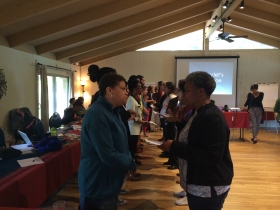This post was authored by Vanessa Daniel, Executive Director of Groundswell Fund. It first appeared on the What is a Justice Funder? blog of the Bay Area Justice Funders’ website and is reprinted with permission.
When funders offer grantees technical assistance or capacity building support, already imbalanced scales of power can become even more skewed. As a trusted funder colleague once told me, “There is a big difference between being offered technical assistance and being (in Terminator voice) technically ASSISTED.” Capacity building is hard for funders to get right, despite the best intentions. Even though many of us funders have been in grantee shoes at some point, we sometimes forget what it felt like to make a command performance at a funder-sponsored grantee convening based on the untested expectation that, in the course of two days, everyone will become great allies and walk out ready to coordinate strategy. We forget suffering through a one-size-fits-all funder-sponsored training that only marginally relates to our work or being force-fed a consultant that we never asked for and don’t have the bandwidth to use.

Groundswell Fund 2014 Integrated Voter Engagement Convening. Image source: Groundswell Fund
Three years ago, when Groundswell Fund decided to enter the treacherous waters of capacity building around Integrated Voter Engagement (IVE), we did so acutely aware of the pitfalls it would entail. But even that didn’t prevent us from missteps and many “teachable moments.” After an 18-month pilot, we launched a full 24-month program with 10 groups in early 2014. Here are the top 10 lessons we learned — and continue to learn — gleaned from either getting it right or dead wrong the first time:
- Co-design with grantees. Our current program is measurably stronger than the pilot because we engaged grantees in the nitty gritty of its design. They joined a design team of staff and IVE experts to review participant feedback and re-tool the program in major ways – from the number of months it would run to the scale of grant support allocated to participating groups.
- Don’t fear failure. Colleague Sujatha Jesudasen of CoreAlign recently reminded me of the famous Marshmallow Challenge: kindergartners consistently beat business school students in a timed competition to build the tallest tower using a marshmallow and several sticks of spaghetti. They win because they try and fail many times until they find a method that works. In contrast, business students spend all their time arguing about a plan, leaving themselves only a short time to actually do something. The IVE program’s mantra has become: be nimble, fail fast, welcome and metabolize grantee feedback, re-work, and re-try.
- Hire an external evaluator. A program officer recently told me she knew she had become a funder when people started praising her every idea and complimenting her hair. We can’t fail fast and improve if we’ve created communication channels engineered for compliments rather than honest critiques. Few grantees have the hutzpah to tell us when they object to something we are doing; most, for good reason, fear leveling with us because too much is at stake. A neutral third party evaluator who can aggregate and anonymize feedback is critical to surfacing the info needed to improve program.
- Make capacity building programs optional. Forcing harried, under resourced groups to participate in something they wouldn’t voluntarily sign up to do is a set up for failure.
- Communicate expectations and agreements clearly and precisely. The main problem with, as the cliché says, “building the plane while flying it,” is that no one wants to be a passenger on that flight. Spell out measurable benchmarks clearly, in detail, and in writing, and consider using an MOU that leaves no doubt what grantees and funder are each committing to do.
- Tailor support. One-size-fits-all approaches are less efficient and effective than tailored ones that meet grantees where they are with the tools needed their particular context. For example, if you offer coaches or consultants, offer a diverse pool whose members have a variety of technical skills, styles, and cultural competencies for grantees to choose from. Co-create work plans right-sized to each organization’s capacity and mission. It is possible to offer tailored support while simultaneously maintaining some program-wide structures and benchmarks.
- Vet participants carefully. Given what’s at stake (funding), grantees sign up for a capacity building program for any number of bad reasons that lead to unhappy campers on all sides once the reality of the actual work sets in. A detailed pre-program assessment via phone or in-person interview of a grantee’s capacity, readiness, and hunger to do the work and alignment with the program’s theory of change goes a long way toward positive outcomes for all parties.
- Be real. A fitness coach who tells someone they can run a marathon without training is setting that person up to fail. A program that tells groups they can build electoral power without essential tools and capacities like power mapping, geographic targeting, and a methodical use of data is no different. Effective capacity building programs maintain strong relationships with grantees while pushing them beyond their comfort zone – and ensuring they have the resources to succeed.
- Evaluate. Co-design evaluation metrics with grantees and experts so data gathered are useful not only to you, but to the participating groups, and the field at large. One of the reasons smaller grassroots organizing groups don’t get full credit for their work is that they can’t document impact because they don’t track and benchmark it. Ensuring that groups participating in capacity building programs come away with new tools and resources to track and document impact makes such programs useful in the long term, and beyond the specific context of the program
- Ensure adequate staffing. If you are running a capacity building program in-house, hire a staff person with deep experience and technical knowledge of the subject area to oversee it, even if you are contracting out key pieces of the work to intermediaries or consultants. Groundswell’s IVE program leapt forward with the hire of a seasoned IVE practitioner, Letetia Jackson, to run it.
My hope in sharing these lessons learned is that they will be helpful to grantmakers considering similar programs. At the core of these lessons is our ability as grantmakers to be accountable and in greatest service to grassroots power building efforts; with a focus on efforts led by communities directly impacted by the policies and systems they seek to transform.

Vanessa Daniel is the Executive Director of Groundswell Fund, which supports a stronger, more effective U.S. movement for reproductive justice by mobilizing new funding and capacity-building resources to grassroots organizing efforts led by low-income women, women of color and transgender people. Vanessa has 18 years of experience working in social justice movements as a union and community organizer, researcher, freelance journalist, and social justice grantmaker. She serves on the Steering Committees of the Bay Area Justice Funders Network and the Health and Environmental Funders Network.

